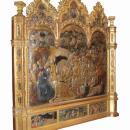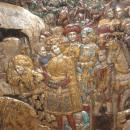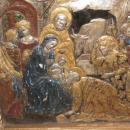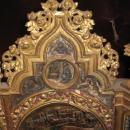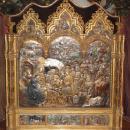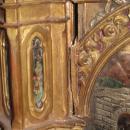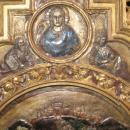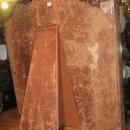Antique Gothic Style Enameled Silver Christian Altar Altarpiece After Fabriano








This extraordinary enameled silver panel in giltwood frame depicts the Adoration of the Magi, after the influential gothic masterpiece by Gentile da Fabriano (c1370-1427), and is believed to date from the early to late 19th century. Protected by silk-lined doors on left and right, it measures 31 by 27 in (78.8 by 38.6 cm) when closed. Title at the base reads “GENTILE DA FABRIANO (SEC. XV) L’ADORATION DEI MAGI”. Virtually every detail in the original work by Fabriano has been faithfully addressed in this wonderful nineteenth century work of art. The wooden frame exhibits the finest design and carving, and its original gilded surfaces are in excellent condition. The frame is rectangular in shape, with three arches, surmounted with gothic pediments including the painted depictions of saints and angels, and reticulated organic flourishes along the top. It resides in its original wooden leather covered case. We have found no hallmarks. Overall condition is good. There are small losses to the panel, and a few breaks and repaired breaks as seen in our images below. There are patches to the red velvet lining of the case, and considerable wear to the leather which is consistent with age.<br>
<br>
The panel itself features polychrome enamel and gilt decorations over a surface featuring shallow repousse technique, for an overall scene in low relief. Extensive use of gold abounds across the surface, while the seated Mary stands out prominently in blue. Red, green and light blue enamel accent the scene throughout. Intricate patterns on the clothing of the wisemen are the result of magnificent respousse and chasing techniques, along with precise enameling. Overall, this is the largest and most impressive representation of Fabriano’s painting known to appear for sale in any medium in recent decades, and no similar work of art has appeared at major auction worldwide in the past twenty years.<br>
<br>
The original masterpiece by da Fabriano from 1423 was painted in tempera on wooden panel, housed in gilded wooden frame, and currently resides in the collection of the Galleria degli Uffizi in Florence, Italy. The original large tempera on wood, also called Pala Strozzi, was commissioned by a wealthy banker and intellectual Palla Strozzi for the family chapel in the church of Santa Trinita. It is widely considered one of the greatest masterpieces of international gothic style, with its elegant and fairy tale atmosphere and figures in sophisticated poses. The Adoration of the Magi theme was common since it allowed to hint at the economic prosperity and cultural superiority of who commissioned the work. The procession of the Magi fills the whole composition and is a chance to flaunt plushy clothes and golden decorations. Behind the three Magi we can recognize the portrait of Palla Strozzi in the man with the falcon. The sumptuous clothes of the characters, the refined harnesses of the horses, the description of the landscape and the even more magnificent carved wood frame make this work a veritable masterpiece.<br>
<br>
Gentile was an Italian master known around the world. He worked in various places in central Italy (mostly in Tuscany), and his best known works are Adoration of the Magi and the Flight into Egypt. Gentile was born in or near Fabriano, in the Marche. His mother died some time before 1380, and his father, Niccolò di Giovanni Massi, retired to a monastery in the same year, where he died in 1385. Little is known of his education and training. One of his first known works, a Madonna with Child, c 1395-1400 (now in Berlin) shows the influence of the northern Italian late-Gothic painting. By around 1405, Gentile da Fabriano was working in Venice. He is known to have painted a panel for the church of Santa Sofia (now lost), and Gentile Bellini possibly worked in his workshop. Between 1408 and 1409, he painted a fresco (also lost) in the Doge's Palace depicting the naval battle between the Venetians and Otto III. In Venice he knew Pisanello and perhaps Michelino da Besozzo.<br>
<br>
From 1410-1412 is one of his first masterworks, the Valle Romita Polyptych (now at the Pinacoteca di Brera). In 1410-1411 he was at Foligno, where he frescoed the Palazzo Trinci. In 1414 he moved to Brescia, at the service of Pandolfo III Malatesta, and painted the Broletto Chapel, a work now mostly lost. In the Spring of 1420 he was again in Frabriano. In August 1420 he travelled to Florence where in 1423 he painted Adoration of the Magi, which is considered one of the great masterpieces of the International Gothic style. His other works in Florence include the Quaratesi Polyptych (May 1425). In 1425 he was in Siena, where he painted a Madonna with Child, now lost, for the Palazzo dei Notai on Piazza del Campo. Until October he was in Orvieto, where he painted his fresco of the Madonna and Child in the cathedral. In 1427 he arrived in Rome, commissioned by Pope Martin V for the decoration of the nave of the Basilica of St. John in Lateran, which was completed by Pisanello after his death. Gentile is known to have died before 14 October 1427. He is commonly said to have been buried in the church now called S. Francesca Romana in Florence, but his tomb vanished. There is evidence, however, that he may be buried in the church of Santa Maria in Trastevere in Rome, the place of his death. He left no works in the Marche, except possibly a Madonna and Child in the Duomo at Sant'Angelo in Vado, near Urbino. He also left one painting in Venice. Literature:<br>
<br>
Uffizi.org/artworks/adoration-of-the-magi-by-gentile-da-fabriano<br>
Mack, Rosamond E., Bazaar to Piazza: Islamic Trade and Italian Art, 1300-1600, University of California Press, 2001.<br>
Gentile da Fabriano e l'altro Rinascimento, catalogo della mostra (Fabriano, 21 Aprile-23 Luglio 2006), Electa, 2006.<br>
Fabio Marcelli, Gentile da Fabriano, Silvana, 2005.<br>
Andrea De Marchi, Gentile da Fabriano. Un viaggio nella pittura italiana alla fine del gotico, Federico Motta, 2006 (I ed. 1992).
